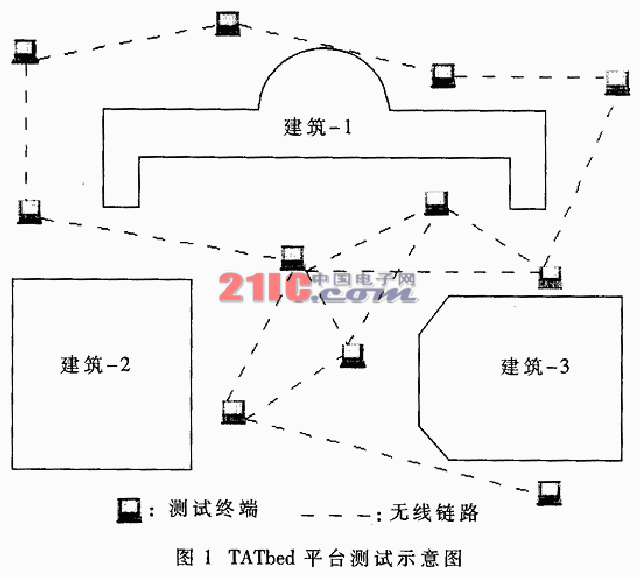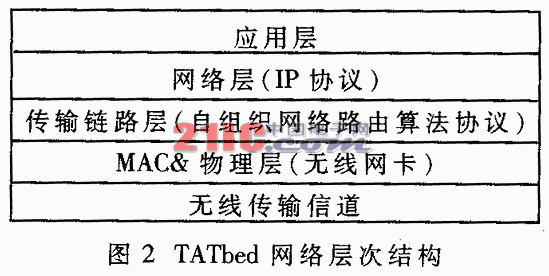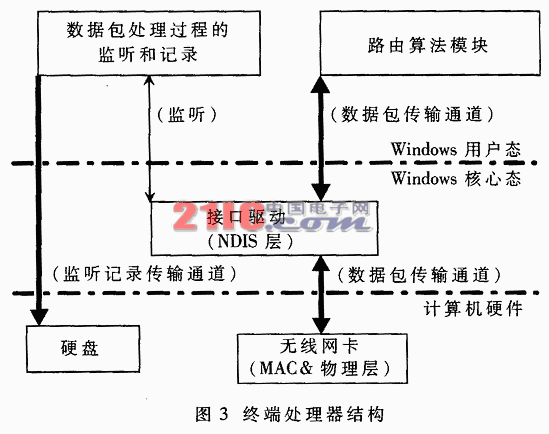Abstract: Designed and established a wireless self-organizing network test platform system-TATbed (Tsinghua Ad hoc network Test bed). By developing the underlying network card driver and routing algorithm protocol module, the ordinary PC becomes an independent self-organizing network terminal; at the same time, the measured performance index of the network is obtained by monitoring and counting the data transmission status between multiple terminals. Currently, testing support for multiple routing algorithm protocols has been implemented in the platform.
The multi-hop self-organizing network (Ad hoc network) is composed of multiple independent users with routing (switching) function and the final communication. Adjacent terminals in the network can directly establish an end-to-end communication link; non-adjacent terminals can dynamically search for routes, data packets are forwarded by other terminals, and transmitted to cable routes in a multi-hop manner, and data packets are forwarded by other terminals. Transfer to the final destination terminal in multi-hop mode. In the self-organizing network, the rapid change of the wireless channel environment and the mobility of the terminal cause the network topology to change constantly. Therefore, how to search and maintain effective routes has become a difficult problem in the research of self-organizing networks. In recent years, researchers have proposed a variety of draft routing protocols, such as DSR, AODV, SAR, etc. The performance evaluation data is basically obtained by simulation using network module software such as OPNet, NS-2 / GloMoSim. Because the wireless channel, terminal distribution, terminal motion and other models used in the simulation software are somewhat simplified compared to the real network environment, so before the self-organizing network technology enters the commercial application, build an actual Ad hoc network hardware test platform It is necessary to evaluate the performance of network protocol algorithm design at all levels. However, existing wireless terminals do not support any self-organizing routing protocol. 
This paper designs and actually establishes a wireless self-organizing network test platform system TATbed. By loading the corresponding underlying driver and test system software, the ordinary PC equipped with a wireless network card becomes the actual terminal of an independent self-organizing network; the test platform provides a unified module interface for various routing algorithm protocols and sets the corresponding routing The algorithm and the test parameter locust can obtain the statistical results of the actual performance of this routing algorithm by detecting the data transmission status between each terminal. At the same time, the test platform is compatible with various wireless network card standards, such as IEEE802.11 series, HiperLan series, etc. At present, the TATbed test platform has integrated a variety of Ad Hoc network proprietary routing algorithm protocols, AODV, DSR, SAR, FSR, ZRP, etc., and can truly reproduce the actual environment in which Ad hoc network applications are located (including terminal mobility And the actual situation of objective channels), providing an operable platform for studying the performance and characteristics of Ad hoc networks in various environments, and testing, evaluating, and optimizing the structural design of Ad hoc networks and the design of network protocol algorithms at each layer It has more reference value.
The structure of this paper is as follows. The first section introduces the overall structure of the test platform system, the second section introduces the key module design of the system, and the third section introduces its practical application and summary.
1 Platform structure
The design goal of the TATbed wireless self-organizing network test platform is to develop test terminals that support a variety of Ad hoc network routing algorithm protocols to build an actual Ad hoc test network, and to detect various Statistics and evaluation of actual performance indicators.
The TATbed test platform consists of a certain number of independent self-organizing network terminals. In the actual platform design, a self-organizing network terminal supporting multiple routing algorithm protocols was developed on the basis of a PC (notebook computer) equipped with a wireless network pupil, and each terminal set up an Ad hoc network by itself according to the set routing algorithm protocol And data transmission. Figure 1 is a schematic diagram of the actual test of the TATbed platform. 
The software system of TATbed test platform includes transmission of any generator, terminal processor and data statistic.
Before the test starts, the transmission task generator will generate a starting transmission task list for each terminal according to the set test parameters to accurately control the transmission load of the test process network. In the transmission task list, the source sending node, the final destination node, the number of data packets, and the sending time of each group of data packets in the whole test process are defined.
After the test starts, the terminal processor on each terminal will read its corresponding transmission task list, enter the data packet sending process at a specified time, process the data packets that need to be sent, and listen to the data packets received by the wireless network card and perform Handle accordingly. During the test, the terminal software module records the information of each packet received and sent by the node, including the time of receipt (transmission), packet header information, and packet length.
After the test is completed, according to the initial transmission task list of the entire network and the record of the received and sent packets saved by each terminal during the test, the data statistic device statistically analyzes and calculates the corresponding test indicators, including network tolerance and node average Throughput, successful packet transmission rate, average packet transmission delay, delay jitter, average packet transmission path hops, system routing overhead, etc.
2 Self-organizing network test terminal design
Since all existing communication terminal devices do not support any self-organizing network protocol algorithm, the development of self-organizing network test terminals has become the key to the construction of the entire test platform. In the TATbed test platform, by installing a terminal processor on a PC equipped with a wireless network card, it supports a variety of self-organizing network routing algorithm protocols and becomes a terminal in an actual self-organizing network. 
Under the existing standard PC system, the network layer uses the IP protocol to identify the connection address between the terminals. The transmission tasks of the application layer are directly sent to the wireless network card after data packaging, and only when the source of the data packet Only when the node and the destination Qiong Koala are within the coverage of each other's wireless network card can IP packets be successfully sent. The terminal itself does not support any routing function. In the TATbed test platform system, the self-developed driver module is loaded between the MAC layer and the network layer of the terminal to support multi-hop transmission in the wireless self-organizing network to form a virtual transmission link for the transmission of ordinary data packets. Provide transmission routing, as shown in Figure 2.
The terminal processor is developed on the basis of the NDIS (Network Driver Interface SpecificaTIon, Network Driver Interface Specification) layer provided by the Windows operating system, and includes three parts: the underlying interface driver, the routing algorithm module, and the data packet monitoring record. Its structure is shown in Figure 3.
To evaluate the performance of various routing algorithm protocols, the interface driver in the terminal processor is designed as a custom standard routing algorithm interface. This interface separates the routing searching and other functions completed by the routing algorithm protocol from the network layer of the civil system, including the transfer between the upper and lower layers and the filling of the header content, making the routing algorithm protocol a separate need to be embedded. Submodule. Different routing algorithm protocols only need to follow the interface definition to write corresponding sub-modules. At present, the TATbed test platform system can support the testing and evaluation of various self-organizing network routing algorithms such as AODV, DSR, SAR, WRP, Fisheye, CBRP, and ZRP. At the same time, because the terminal processor interface driver is loaded on the NDIS layer, making the test platform transparent to the MAC layer protocol, the test platform can choose various wireless network cards based on different transmission standards according to the test needs. At present, the network card based on IEEE802.11b standard is selected for testing.
In order to support multi-hop data transmission, the header of the data packet transmitted in the test system is extended on the basis of the standard Ethernet-MAC header, and the type information and path information specified in the routing algorithm protocol are added, as shown in Figure 4 .
Figure 4
The 0th to 13th bytes of the packet header are the standard Ethernet-MAC header format, and the 14th to 27th bytes are the extended "routing information" field, followed by the actual user data. For the data packet from the upper layer (network layer), the terminal reads the final destination address of the packet from its IPv4 standard header and saves the "final destination address" in the "final destination node IP" of the "routing information" field Address "item; at the same time call the routing algorithm module, obtain its corresponding multi-hop routing information according to its final destination address, and write the address of the receiving node of the actual next hop to the" Next " Jump to the MAC address of the receiving node, and then send this data packet to the next layer (MAC & physical layer) wireless network card for processing and sending. For the data packet received from the underlying wireless network card, the terminal reads the "final information" field "final "Destination node address", if this address matches its own address, it will be handed over to the upper network to continue. If it does not match, then the routing algorithm module will be called to obtain the address of the receiving node of the next hop in the corresponding multi-hop route, and then handed over to the wireless network card .For other non-data packets specified in the routing algorithm protocol, such as routing search packets, routing response packets, routing failure packets, periodic handshake Information packets, etc., are marked in the "packet type" field, and the wireless network card directly sends and receives the corresponding routing algorithm module for processing.
3 System application
TATbed wireless self-organizing network test platform has developed an actual wireless terminal supporting a variety of self-organizing network routing algorithm protocols on an ordinary PC to build an actual wireless self-organizing network test system. Using this platform, the author has successfully measured and analyzed the performance of AODV and SAR routing algorithms under various actual network environment parameters. The test results can be applied to the performance evaluation and design optimization of the actual self-organizing network algorithm. At the same time, the design of the TATbed terminal software module makes it applicable to any hardware device based on the Windows kernel, with a high degree of versatility, flexibility and scalability, in the wireless self-organizing network actual network system performance measurement, network planning optimization Many aspects such as design, performance evaluation of algorithm protocols at various levels of the network have their unique application advantages.
Double Socket Extension,Stainless Steel Wall Sockets,Gang Socket Extension,Zebronics Power Extension Socket
Heikki Technology Co., Ltd. , https://www.heikkipower.com